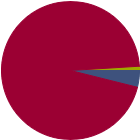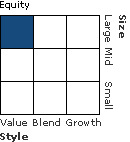| DWS CROCI International VIP A |
|
 |
|
| Release date as of 2025-09-30. Data on page is subject to change. |
|
|
Overall Morningstar
Rating™
|
| What is this?
|
|
 |
| As of 2025-09-30 |
|
Out of 343
Foreign Large Value Funds
|
|
|
|
|
|
| Total Fund Assets ($ Mil) |
| 86.45 |
|
|
|
| Investment Objective & Strategy |
|
| The investment seeks long-term growth of capital.
|
|
| Although the fund can invest in companies of any size and from any country, it invests mainly in common stocks of established companies in countries with developed economies (other than the United States). Portfolio management will select stocks of companies that the advisor believes offer economic value utilizing the Cash Return on Capital Invested (CROCI®) strategy as the primary factor, in addition to other factors. |
|
|
| Morningstar Category: Foreign Large Value |
|
| Foreign large-value portfolios invest mainly in big international stocks that are less expensive or growing more slowly than other large-cap stocks. Most of these portfolios divide their assets among a dozen or more developed markets, including Japan, Britain, France, and Germany. These portfolios primarily invest in stocks that have market caps in the top 70% of each economically integrated market (such as Europe or Asia ex-Japan). Value is defined based on low valuations (low price ratios and high dividend yields) and slow growth (low growth rates for earnings, sales, book value, and cash flow). These portfolios typically will have less than 20% of assets invested in U.S. stocks.
|
|
|
| Foreign Securities Funds/Emerging Market Funds: Risks include, but are not limited to, currency risk, political risk, and risk associated with varying accounting standards. Investing in emerging markets may accentuate these risks. |
|
|
| % of Net Assets |
 |
U.S. Stocks |
3.9 |
 |
Non-U.S. Stocks |
95.1 |
 |
Bonds |
0.0 |
 |
Cash |
1.0 |
 |
Other |
0.0 |
|
|
 |
| Data through 2025-08-31 |
|
|
|
|
| Morningstar Equity Sectors |
|
|
|
% of Stocks |
 |
Cyclical |
38.63 |
 |
Basic Materials |
6.81 |
 |
Consumer Cyclical |
6.94 |
 |
Financial Services |
24.88 |
 |
Real Estate |
0.00 |
|
|
|
 |
Sensitive |
26.01 |
 |
Communication Services |
2.60 |
 |
Energy |
7.48 |
 |
Industrials |
12.28 |
 |
Technology |
3.65 |
|
|
|
 |
Defensive |
35.36 |
 |
Consumer Defensive |
9.59 |
 |
Healthcare |
20.46 |
 |
Utilities |
5.31 |
|
| Data through 2025-08-31 |
|
|
|
| Morningstar World Regions |
|
| % Fund |
| Americas |
3.9 |
|
| North America |
3.9 |
| Latin America |
0.0 |
|
| Greater Europe |
61.8 |
|
| United Kingdom |
21.4 |
| Europe Developed |
39.6 |
| Europe Emerging |
0.0 |
| Africa/Middle East |
0.8 |
|
| Greater Asia |
34.3 |
|
| Japan |
24.3 |
| Australasia |
2.9 |
| Asia Developed |
5.8 |
| Asia Emerging |
1.4 |
|
| Data through 2025-08-31 |
|
|
| Total Number of Stock Holdings |
73 |
| Total Number of Bond Holdings |
0 |
| % of Net Assets in Top 10 Holdings |
29.39 |
|
|
| Turnover % |
(as of 2024-12-31) |
60.00 |
| 30 Day SEC Yield % |
3.20 |
|
|
Sector |
Country |
% of Net
Assets
|
 |
 |
 |
 |
 |
|
Sanofi SA |
 |
France |
3.35 |
|
Banco Santander SA |
 |
Spain |
3.20 |
|
HSBC Holdings PLC |
 |
United Kingdom |
3.03 |
|
Komatsu Ltd |
 |
Japan |
2.94 |
|
Banco Bilbao Vizcaya Argentaria SA |
 |
Spain |
2.93 |
 |
|
Ono Pharmaceutical Co Ltd |
 |
Japan |
2.84 |
|
Shionogi & Co Ltd |
 |
Japan |
2.80 |
|
Imperial Brands PLC |
 |
United Kingdom |
2.80 |
|
UniCredit SpA |
 |
Italy |
2.79 |
|
TotalEnergies SE |
 |
France |
2.71 |
 |
|
 |
|
|
|
|
|
| Lending, Credit and Counterparty, Currency, Foreign Securities, Loss of Money, Not FDIC Insured, Market/Market Volatility, Equity Securities, Industry and Sector Investing, Restricted/Illiquid Securities, Pricing, Management |
|
| Show Risk Definitions |
|
|
| Inception Date: 1987-05-01 |
|
| Di Kumble (2014-05-01) |
|
| Managing Director, Senior Portfolio Manager, Head of Tax Managed Equities: New York
-Joined the Company in 2003 with 7 years of industry experience. Prior to joining, Di served as a Portfolio Manager at Graham Capital Management. Previously, she worked as a Quantitative Strategist at ITG Inc and Morgan Stanley
-PhD in Chemistry from Princeton University; CFA Charterholder |
|
| John Moody (2016-05-01) |
|
| Vice President, Portfolio Analyst / Portfolio Manager: New York
-Joined the Company in 1998. Prior to his current role, John served as a Business Manager for Active Equity. Previously, he was a Portfolio Analyst for EAFE, Global and Technology Funds and an Investment Accountant for International Funds. John began his career as a Client Service Associate for the International Institutional Equity Group
-BS in Business Management from Fairfield University |
|
|
|
| DWS Investment Management Americas, Inc. |
|
|
|
|
|
|
|
|

© Copyright 2025 Morningstar, Inc. All rights reserved. Morningstar, the Morningstar logo, Morningstar.com, Morningstar Tools are either trademark or service marks of Morningstar, Inc. The information contained herein: (1) is proprietary to Morningstar and/or its content providers; (2) may not be copied or distributed; and (3) is not warranted to be accurate, complete or timely. Neither Morningstar nor its content providers are responsible for any damages or any losses arising from any use of information. Past performance is no guarantee of future performance. |
|
Past performance is no guarantee of future results.
Returns will vary and shares may be worth more or less than their original cost when sold.
|
|





















